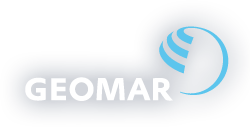| Short Name: GEOMAR |  |
| Country: Germany |
Description
Helmholtz Zentrum Fur Ozeanforschung Kiel is GEOMAR Helmholtz Centre for Ocean Research Kiel. It is one of the world’s leading institutions in the field of marine sciences. The center’s mission is to investigate the physical, chemical, biological and geological processes in the global ocean from the seafloor to the atmosphere. With its scientific impact, size, infrastructure and research agenda, GEOMAR is the leading “blue ocean” research center in Germany. GEOMAR has a modern and efficient research infrastructure at its disposal. The center manages four research vessels, the only manned research submersible in Germany and unmanned deep-sea robots including ROVs and AUVs
Role
GEOMAR are involved in WP2 Transnational Access.
Access to Research Vessels and related infrastructure: RV ALKOR [Regional].
Research vessels of different types and sizes, and underwater vehicles provide the necessary platforms for present and future research at GEOMAR and for the implementation of the associated OCEANS scientific programme. They provide the necessary platforms for a wide-range of science programmes that investigate open ocean and seafloor environments. GEOMAR has two medium-sized research vessels, POSEIDON and ALKOR. Associated with these ships are mobile systems (underwater vehicles) and their home base, GEOMAR’s Technology and Logistic Centre (TLZ).
In Eurofleets+, GEOMAR will also undertake activities in WP1 Project Management, WP5 Stakeholder engagement, and WP8 Foresight: Legacy and Roadmap.
Relevant Publications
-
GEOMAR Helmholtz-Zentrum für Ozeanforschung. (2015). Research Vessel ALKOR. Journal of large- scale research facilities, 1, A35. http://dx.doi.org/10.17815/jlsrf-1-61
-
Feldens, P., Diesing, M., Schwarzer, K., Heinrich. C., Schlenz, B., 2015. Occurrence of flow parallel and flow transverse bedforms in Fehmarn Belt (SW Baltic Sea) related to the local Palaeomorphology. – Geomorphology, 231, 53 – 62.
-
Schwarzer, K., Bohling, B., Heinrich, H., 2014. Submarine hard bottom substrates in the western Baltic Sea – human impact versus natural development. – J. Coastal Res., SI 70, 145 – 150.
-
Sommer, S., Schmidt, M., Linke, P. (2015) Continuous inline tracking of dissolved methane plume at a blowout site in the Northern North Sea UK – water column stratification impedes immediate methane release into the atmosphere. Marine and Petroleum Geology 68, 766-775. DOI 10.1016/j.marpetgeo.2015.08.020
-
Hinrichsen, H.H., Lehmann, A., Petereit, C., Nissling, A., Ustups, D., Bergström, U., Hüssy, K., 2016 Spawning areas of eastern Baltic cod revisited: Using hydrodynamic modelling to reveal spawning habitat suitability, egg survival probability, and connectivity patterns. Progress in Oceanography 143:13-25.
